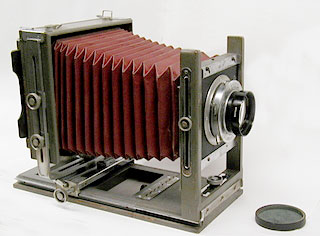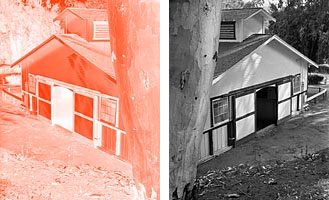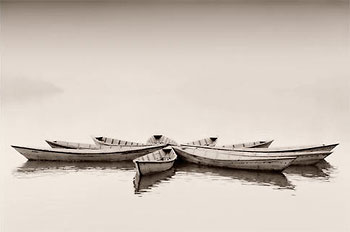| my head is going to explode
The pressure building inside my head is not, at least at the moment, caused by the destructive actions of the Bushies but is actually from realizing what some of the creative possibilities are with some of the photography tools I'm acquiring.
The cause of this intense pressure was the the trade, for $17.15 worth of film and shipping, of a 5x7 view camera, probably a Burke and James.

Since the trader is throwing in a 4x5 graflok back that I can modify into a reducing back for the 5x7, and with the Speed Graphic that I am refurbishing, I am set up in the large format department. Both cameras need some work but, when finished, they will give me 3.25x4.25, 4x5, and 5x7 formats.
The 3.25x4.25 and 4x5 formats are enlarging formats. While 5x7 is sometimes an enlarging format (talk about *big* enlargers), it is big enough for contact printing. And this is the direction that has me so excited. I swore that I would never print in a darkroom again. The digital controls you have in Photoshop let you do things impossible with an enlarger. But a 5x7 or 8x10 contact print is breathtaking. Literally.
Back in the early 1970s I took a fine art black and white printing class. We met once a week for instruction. Part of each class was to bring in a print for evaluation. I didn't have an enlarger when I started the class so I took an old Kodak 5x7 that I had as a display camera, slapped on one of my 4x5 lenses, made some exposures and contact printed one of them. On class day we showed up with our prints. Most in the class were shooting 35mm Tri-x and making 11x14 prints. After looking at several of the large prints with giant grain and very few tones, I sheepishly passed down my little 5x7 print. The instructor looked at it and let out an audible gasp. For sharpness and tonality, there is nothing like a large contact print.
Part of me has wanted to do large contact prints but that part had grown small with the advent of Photoshop. But recently I had, in my Internet explorations for information on developing black and white film for the Speed Graphic, come accross a old photographic paper designed for contact printing that gives incredible results — Azo. Michael Smith and Paula Chamlee use Azo and are dealers for Azo. Their site has lots of information on Azo. So I plan on contact printing the 5x7 negatives, new and old ones from the 1970s, on Azo. That means I need to build a small darkroom.
But wait! There's more! Contact printing Azo (just like Edward Weston) is exciting enough but then, in my googling, I stumbled on making digital negatives. I've known that printing digital negatives for alternative processes that use contact printing has been going on but I've not been one for some of the alternative processes. I guess I will be doing one of the alternative proccesses now. The idea is that you manipulate the image in Photoshop and then, instead of printing the picture on paper, you print the negative image on clear plastic and use that for contact printing. This combines the best of both worlds — digital darkroom and traditional wet darkroom. Dan Burkholder has written the book on this process. This will allow me to take negatives meant for enlarging and put them into photoshop for all the burning and dodging and whatall and then make straight contact prints at whatever size I want. Woo hoo!
Here is another link on contact printing with digital negatives...
Digital Negatives for Contact Silver Printing
|
Most of the shortcomings of the ink jet printer are overcome by printing a negative rather than a positive. Where the dots are sparse, silver clumps fill the area. Where the ink dots are dense, highlights in the print are rendered smoothly. With negatives made with the Epson Photo 1200 in color mode, the resulting silver gelatin prints are easily accepted as fine prints and can be expressively far superior to those made under an enlarger. The results are repeatable - all of the "dodging & burning" being done before the negative is made, and the final print shares the visual and archival traits associated with fine silver printing.
| |

[more]
And an interview with Dan Burkholder...
Dan Burkholder
|
I was first introduced to Dan Burkholder's magnificent photographic work at a gallery in Washington, D.C. Stunned by his landscape images, I went on to find that Dan is also a virtuoso in several other styles or categories of image-making including his revolutionary "pigment-over-platinum" prints. Originator of the digital negative and author of the ground-breaking book Making Digital Negatives for Contact Printing, Dan is a true pioneer who has successfully bridged the gap between chemical and digital photography.
| |

[more]
I like the idea of using film in antique cameras, scanning and processing the image digitally, and then using paper first introduced 100 years ago to the printing. I think my head just popped. |

